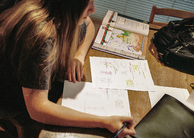Featured Article:Race, Class, and Oppression: Solutions for Active Learning and Literacy in the Classroom
By
2010, Vol. 2 No. 01 | pg. 2/2 | « The Trends in International Mathematics and Science Study, or TIMMS 2003, presents statistical data concerning the math and science achievements by American fourth and eighth graders broken down by the percentage of incidence of poverty in each population group, then a United states average and an international average (Berliner, 2006). The pattern in findings is clear in that the American schools with the most wealth possessed the highest test scores. Those American schools with the highest levels of poverty, 75% or more, achieved the lowest grades on the tests, falling below average in comparison to both the American and international scores in both subjects and grades. The correlation between levels of poverty in a given population and that population’s academic achievement is made clear by this study. Berliner (2006) goes on to emphasize that the lowest scoring students came from schools where at least 75% of the student population were eligible for free or reduced lunch programs, a marker of extreme poverty. Hodgkinson (2008) reports that in addition to test scores, international studies document another alarming statistic. Among industrialized nations, international studies since 1995 have shown the United States to be number one in the total number of children living below the poverty line. To further assess the demographics of those numbers, in 2004, 33% of African American children were poor as opposed to only 14% of Caucasian.Hodgkinson seems to share Berliner’s and Kozol’s feeling that solutions to the achievement gap in economically challenged populations would be most successfully remedied by a long term commitment by educational, government and business leaders to invest in the communities surrounding low performing schools. A reduction in poverty would provide the most positive impact on school and student performance, but it is up to educators to encourage and continue to engage students who may be marginalized and at risk due to economic factors. The American middle class is shrinking. It is a dangerous situation for students who don’t have the stability in their lives that other, more affluent kids enjoy. Socio-Economic Status can create stress for a student living in poverty. Facing unrest at home, the threat of being ostracized in school, or the need to work to support his or her family, the impoverished student is certainly at risk. Couple this factor with racial marginalization, and the danger to the student is increased exponentially. It is truly eye opening to read the works of Berliner and Kozol, understand the statistics, and come to the realization that what previously seemed like fiction, is actually fact. The implications for the student are astounding. With conditions negatively affecting her or his education, the student risks low grades, or dropping out before graduating, resulting in relegation to lower paying jobs and little opportunity to improve their life quality. The cyclic nature of this process is easily visible when one can recognize the risks involved. This cycle can be applied on a larger scale to the family, then to the community. With few exceptions, this cycle perpetuates itself to the benefit of no one. Practices that alienate and exclude the student foster an adversarial relationship that will not lead to a positive outcome for the student, family, or community. For example, tracking students based on assumed ability could be harmful and discouraging. As mentioned previously in this paper, unfounded assumptions can be dangerous to the outcome of a student affected by this type of marginalization. While the issue of poverty is largely a political one, there is much that a classroom teacher can do to encourage and promote the academic success of at-risk students. In the classroom, there are many strategies and approaches to counter the classist and/or racist marginalization of students. Spradlin and Parsons (2008) suggest that teachers take steps to explore their own beliefs about social class and determine the potential influence those beliefs could have on curriculum or teaching style. It is important that the teacher contribute to the marginalized student’s academic achievement in the most positive way possible. In formulating lessons, teachers must recognize the impact of class status on their students and reflect a more relatable, realistic portrayal of the American lifestyle. The danger of making assumptions is ever lurking. Hatt-Echeverria and Urrieta (2003) discussed the compartmentalization of oppression, institutionalized in schools and society with labels and stereotypes abounding. Even within the context of social class and racial marginalization, it is vital for the classroom teacher to look beyond stereotypes, without making assumptions, to appreciate each student before her or him for the individual they are. Each student arrives in class on the first day with their own indigenous knowledge and experiences that may vary greatly even from another student of similar race or class status. To assume an individual’s intelligence or ability based solely on first perceptions is unfair. Making a negative assumption about a student serves only to cement their place in the “matrix of domination” and perpetuate the existing class stratification. Setting and maintaining uniformly high expectations for all students can combat marginalization. The schools included in a study by Ragland, Clubine, Constable, Smith, Council of Chief State School Officers and Texas University (2002) set measurable and high goals for all of its students, while minimizing formal categories and labels. This enables faculty and staff to focus on creating educational opportunities for the students and assess areas for improvement in student and teacher performance. Without tracking and labels, the focus is on the individual, where it belongs, regardless of race or socio-economic status. The schools foster an environment and culture that encourages intellectual development and academic achievement. High expectations are not reserved for the students, but the teachers as well. Following a slip in student performance, teaching staff at one school reviewed curriculum content and instructional methodology to determine the cause of the academic decline. At first it was assumed that a change in student demographics was to blame, but it was later concluded to have been the result of teacher performance. After modifications, the trend was reversed, and the teachers were able to set and meet higher goals (Ragland, et. al, 2002). A teacher’s responsibility to adapt practices to maximize the benefit of marginalized students does not end in the classroom. Active collaboration with parents and their communities must be facilitated in order to identify potential barriers and solutions. The teachers and administrators in the study by Ragland, et. al (2002) view parents as critical partners in the process of education. Collaboration between teachers and colleagues of various subjects contributes to clear communication of student needs and allows for participation in schoolwide intervention strategies. Another means, outside the classroom, to address the issue of class status marginalization is political action. Berliner (2006), in response to the theories surrounding the correlation between poor socio-economic class and low academic achievement, asserts that an increase in the incomes of our poorest citizens might spur an increase in student achievement scores. His assertion is based on the fact that health issues, poor housing and other factors negatively impact the economically challenged student and family. Berliner suggests that school reform is not enough to improve the situation. His belief is that an improvement in the environment in which the children are raised by way of increased financial power is the answer. Berliner and Kozol share similar ideas regarding the monetary solution. In the appendix of Kozol’s The Shame of the Nation (2008), he documents per pupil spending in six metropolitan areas throughout the 2002-2003 school year. There is a clear disparity between the dominantly Caucasian schools with the highest per pupil spending, and the dominantly African American and Latino schools with the lowest. In this scenario, as with Berliner’s, political action on the local, state or federal level would be the appropriate method to address funding issues that contribute to the marginalization of student populations. The issue of marginalization along socio-economic and racial lines is a complicated one. Even after addressing many of the complex challenges faced by students, teachers, families, and communities, there remain many questions yet to answer and many issues to explore in greater depth. With a spectrum of contributing factors ranging from pre-judging a student’s academic ability to discrepancies in per pupil spending, there are nevertheless a number of areas in which a teacher can have a positive impact. The first step is to assist the student in breaking away from the “matrix” by seeing him or her as a unique individual with his or her own knowledge, abilities and experiences. The tradition of oppression and marginalization can be, and often is, self-perpetuating if careful attention and intervention by those with the ability to do so is not duly undertaken. ReferencesBerliner, D. (2006). Our impoverished view of educational research. Teachers College Record, 108(6), 949-995. (ERIC Document Reproduction Service No. EJ737319) Retrieved April 25, 2009, from ERIC database. Dewey, J. (1989). Freedom and Culture. New York: Prometheus Books. Freire, P. (1970). Pedagogy of the Oppressed. New York: The Continuum International Publishing Group, Inc. Good, T., Brophy, J. (2003). Looking in Classrooms, 9th ed. Boston: Pearson Education, Inc. Hatt-Echeverria, B., & Urrieta, L. (2003). Racializing class. Educational Foundations, 17(3), 37-54. (ERIC Document Reproduction Service No. EJ775223) Retrieved April 25, 2009, from ERIC database. Hodgkinson, H. (2008). Demographic trends and the federal role in education. Center on Education Policy, (ERIC Document Reproduction Service No. ED503865) Retrieved April 26, 2009, from ERIC database. Hursh, D. (2008). High-Stakes Testing and the Decline of Teaching and Learning. Lantham: Rowman & Littlefield Publishers, Inc. Kozol, J. (2005). The Shame of the Nation. New York: Three Rivers Press. Ragland, M., Clubine, B., Constable, D., Smith, P., Council of Chief State School Officers, W., & Texas Univ., A. (2002). Expecting success: A study of five high performing, high poverty schools. (ERIC Document Reproduction Service No. ED468010) Retrieved April 26, 2009, from ERIC database. Spradlin, L., Parsons, D. (2008). Diversity Matters: Understanding Diversity in Schools. Belmont: Thomson Wadsworth. Suggested Reading from Inquiries Journal
Inquiries Journal provides undergraduate and graduate students around the world a platform for the wide dissemination of academic work over a range of core disciplines. Representing the work of students from hundreds of institutions around the globe, Inquiries Journal's large database of academic articles is completely free. Learn more | Blog | Submit Latest in Education |


















